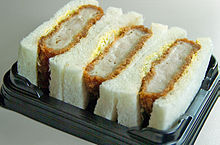Tonkatsu
You can help expand this article with text translated from the corresponding article in Japanese. (January 2020) Click [show] for important translation instructions.
|
 Tonkatsu | |
| Place of origin | Japan |
|---|---|
| Region or state | East Asia |
| Main ingredients | Cutlet (pork fillet or loin), cabbage, miso soup |
Tonkatsu (豚カツ, とんかつ or トンカツ, pronounced [toŋꜜkatsɯ]; "pork cutlet") is a Japanese dish that consists of a breaded, deep-fried/tempura pork cutlet. It involves cutting the pig's back center into 2-3 centimeter thick slices, coating with panko (bread crumbs), frying them in oil, and then serving with Japanese Worcestershire sauce, rice, and vegetable salad (mainly cabbage). The two main types are fillet and loin. Tonkatsu is often served with shredded cabbage, or on a bed of rice (making it a donburi dish, called Katsudon).
Etymology
The word tonkatsu is a combination of the Sino-Japanese word ton (豚) meaning "pig" and katsu (カツ), which is a shortened form of katsuretsu (カツレツ), the transliteration of the English word cutlet, which again derived from French côtelette, meaning "meat chop".
History
Tonkatsu originated in Japan in the 19th century. Early katsuretsu was usually beef; the pork version was invented in Japan in 1899 at a restaurant called Rengatei in Tokyo.[1][2][3] It was originally considered a type of yōshoku — Japanese versions of European cuisine invented in the late 19th and early 20th centuries—and was called katsuretsu or simply katsu.[4]
Preparation and serving

Either a pork fillet (ヒレ, hire) or pork loin (ロース, rōsu) cut may be used; the meat is usually salted, peppered, dredged lightly in flour, dipped into beaten egg and then coated with panko (bread crumbs) before being deep fried.[5]
Tonkatsu is generally served with shredded cabbage.[6] It is most commonly eaten with a type of thick brown sauce called tonkatsu sauce or simply sōsu (sauce), karashi (mustard), and perhaps a slice of lemon. It is usually served with rice, miso soup and tsukemono and eaten with chopsticks. It may also be served with ponzu and grated daikon instead of tonkatsu sauce.[7]
In addition to being served as a single dish, it is used as a sandwich filling or in combination with curry.
Variations



Tonkatsu is also popular as a sandwich filling (katsu sando) or served on Japanese curry (katsu karē). Tonkatsu is sometimes served with egg on a big bowl of rice as katsudon.
In Nagoya and surrounding areas, miso katsu, tonkatsu eaten with a hatchō miso-based sauce, is a speciality.[8]
Variations on tonkatsu may be made by sandwiching an ingredient such as cheese or shiso leaf between the meat, and then breading and frying. For the calorie conscious, konnyaku is sometimes sandwiched in the meat.[citation needed]
Several variations of tonkatsu use alternatives to pork:
- Chicken katsu (チキンカツ) or Tori katsu (鶏カツ), which uses chicken instead, often appears in Hawaiian plate lunches.
- Menchi-katsu (メンチカツ) or minchi katsu (ミンチカツ mince katsu), is a minced meat patty, breaded and deep fried.
- Hamu katsu (ハムカツ ham katsu), a similar dish made from ham, is usually considered a budget alternative to tonkatsu.
- Gyū katsu (牛カツ beef katsu), also known as bīfu katsu, is popular in the Kansai region around Osaka and Kobe.
A similar dish with ingredients other than pork, beef, or chicken is called furai (fry), not katsu (cutlet), such as aji-furai (fried horse mackerel) and ebi-furai (fried prawn).[9]
In popular culture
In Isekai Shokudo light novel series, Pork loin Tonkatsu is the favourite food of Altorius who loves it so much, he strictly enjoyed it only with tonkatsu sauce and beer, refusing to even try any other variations such as Katsu Curry.
See also
References
- ^ 岡田, 哲. とんかつの誕生―明治洋食事始め. p. 166.
- ^ 小菅, 桂子. にっぽん洋食物語大全. p. 122.
- ^ Kaneko, Amy (2007). Let's Cook Japanese Food!: Everyday Recipes for Home Cooking. Chronicle Books. p. 101. ISBN 0-8118-4832-9.
- ^ Jennifer Ellen Robertson, ed. (2005). A companion to the anthropology of Japan. Wiley-Blackwell. p. 421. ISBN 0-631-22955-8.
- ^ Tsuji, Shizuo; Fisher, M. F. K. (2007). Japanese Cooking: A Simple Art. Kodansha International. p. 240. ISBN 4-7700-3049-5.
- ^ Hosking, Richard (1995). A Dictionary of Japanese Food: Ingredients and Culture. Tuttle. p. 159. ISBN 0-8048-2042-2.
- ^ Ono, Tadashi; Salat, Harris (2013). Japanese Soul Cooking: Ramen, Tonkatsu, Tempura, and More from the Streets and Kitchens of Tokyo and Beyond. Potter/Ten Speed/Harmony/Rodale. ISBN 9781607743538. Retrieved 21 July 2020.
- ^ http://www.nic-nagoya.or.jp/en/e/archives/629
- ^ "Katsu" (in Japanese). Dictionary of etymology.
Difference between katsu
and furai}} is not defined explicitly; however, cuisine made of fish or vegetables are not called katsu}} but called furai}}. }}
